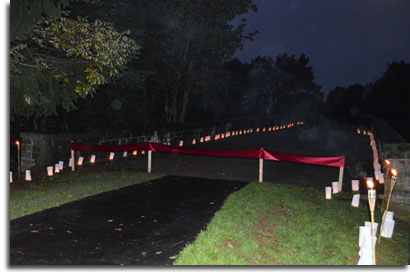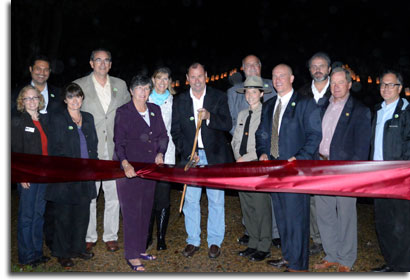September 20-22, 2013
By Francis Champ Zumbrun
The 200-year bicentennial celebration of the Casselman River Bridge occurred on the weekend of September 20-22, 2013. Department of Natural Resource (DNR) officials placed an information kiosk at entrance of the Casselman River Bridge State Park in time for the weekend event. The exhibit explains in a few words the colorful history of the bridge:
"Spanning the Casselman River and supporting 200 years of hooves, boots, sleigh runners, and wheels of every type and description, the Casselman River Bridge begins its third century on the National Road east of Grantsville, Maryland. It is one of the oldest surviving bridges in the nation."
 In 1806, the United States Congress commissioned David Shriver Jr., a celebrated Cumberland civil engineer, to locate, plan, and construct the National Road, including the Casselman River Bridge. Shriver personally took charge of the bridge construction that began in 1813. The stone arch of the bridge is 26 feet wide, 3 feet thick, and from end to end spans 80 feet, designed to accommodate C&O Canal boats should they someday cross the Alleghenies. When it opened to traffic in 1817, the Casselman River Bridge was the largest single span stone arch bridge in America.
In 1806, the United States Congress commissioned David Shriver Jr., a celebrated Cumberland civil engineer, to locate, plan, and construct the National Road, including the Casselman River Bridge. Shriver personally took charge of the bridge construction that began in 1813. The stone arch of the bridge is 26 feet wide, 3 feet thick, and from end to end spans 80 feet, designed to accommodate C&O Canal boats should they someday cross the Alleghenies. When it opened to traffic in 1817, the Casselman River Bridge was the largest single span stone arch bridge in America.
Since its construction, many famous personalities have crossed over this bridge including Presidents James Monroe, Andrew Jackson, William Henry Harrison, James Polk, and Zachary Taylor, and then Congressman Abraham Lincoln. In 1953, following the completion of a new bridge and Route 40 nearby, officials closed the Casselman River Bridge to all but pedestrian traffic.
In 1957, the State Roads Commission acquired several acres west of the bridge. With the assistance of the Department of Forests and Parks, the two agencies developed the park and picnic area you see here today. In 1964, the Secretary of Interior and the National Park Service declared the bridge a National Historic Landmark. In 1972 and 1993, the State Highway Administration transferred portions of the site to the Department of Natural Resources. The bridge is now the focal point of the four-acre Casselman River Bridge State Park."
The exhibit also recognizes two champions whose leadership helped saved the bridge from destruction, Maryland Delegate Harry C. Edwards in the 1950s, and Maryland Delegate DeCorsey E. Bolden in the 1970s. For the new exhibit, staff from The Garrett County Historical Society freely offered invaluable assistance, providing rare photographs and valuable information.
The Bicentennial celebration provided a full schedule of events. On Friday night, September 20, the staff of Penn Alps Restaurant and Craft Store kicked off the event with dinner. Dr. Neal Brooks gave a historical presentation about the National Road. The highlight of this evening was the unveiling of a commemorative painting of the Casselman River Bridge community by nationally known artist, Mark Stutzman.
On Saturday, September 21, the staff of Casselman Inn gave a brunch buffet. Afterwards, Al Feldstein, the author of many local histories, gave an informative program about the National Road with a special focus on the road in the Grantsville area. Other speakers gave talks at other locations, including one about the Vagabonds (Thomas Edison, Harvey Firestone, and Henry Ford), when they passed through the Grantsville area in 1921, promoting for the first time the linking of the automobile with outdoor recreation.
On both Saturday and Sunday, the Spruce Forest Artisan Village hosted a Plein Air painting event, in which artists painted outdoors and competed for prizes. On Sunday there was also an outstanding musical performance at the Penn Alps church by champion fiddler player, Hanna Livingston, who performed an original song about the National Road composed by Eric Kitchen called, “The Road to the Ohio.”
Unfortunately, it rained on the parade that organizers had planned on Saturday. However the weather did clear just in time for a formal ceremony that was held on the Casselman River Bridge in the early evening. Several state and local officials, including representatives of the Maryland Department of Natural Resources, spoke about the significance of the National Road, the Casselman River Bridge, and the Casselman River Bridge State Park.

Just before the ceremony, state park rangers and volunteers adorned the bridge with two hundred candle luminaries in honor of its 200-year history. The luminaries provided an almost mystical setting as darkness set in and the moon began to rise behind the speakers.

Formal Ceremony
This photograph was taken at the formal rededication ceremony of the Casselman River Bridge on its 200th birthday on September 21, 2013 with 200 candle luminaries on the bridge, some seen in the background.
Front Row from left to right: Dawn Hein, Director Mountain Maryland Gateway to the West Heritage Area; Amanda Conn, Deputy Director Maryland Department of Planning; Julliana Albowitcz, Field Representative Senator Mikulski; Secretary Joe Gill, Maryland DNR; Erin Thomas, Park Manager Casselman River Bridge State Park; Mayor Paul Edwards, Town of Grantsville; Delegate Wendell Beitzel; Robin Summerfield, Field Representative, Senator Cardin
Back Row from left to right: Kevin Mack, Field Representative Congressman John Delaney; State Senator George Edwards; Marci Ross, Assistant Director, Tourism Development – Maryland Office of Tourism Development; Jim Raley, Garret County Commissioner; Bob Gatto, Chairman Garrett County Commissioners.
Photo courtesy of the Garrett County Chamber of Commerce.
Senator George Edwards felt the formal ceremony, that included several young honor guards, captured the essence of what the Casselman River Bridge bicentennial was all about: "The Bridge is a link for those living that connects them to the past, present and future. The celebration is not just about a bridge, but this celebration is also about people, a people who built the bridge and the National Road, the road that built a nation. These people had a vision and had the ability to manifest that vision into reality, and America is better off for it. Their accomplishments should inspire us all."
Note: Casselman River Bridge State Park is a 4-acre parcel located east of Grantsville in Garrett County on U.S. Route 40. It is a popular area for fly fishermen, photographers, and history enthusiasts. When the 80-foot span was erected in 1813, it was the longest single span stone arch bridge in the United States. Skeptics predicted that the bridge would collapse once the supporting timbers were removed - yet the bridge stood, serving as an important link on the National Road from 1813 to 1933. Although the bridge no longer carries vehicular traffic, it is open to pedestrians.
Today the Casselman River Bridge stands as a picturesque relic of Maryland's early transportation history, and a tribute to those who designed and built the National Road.
Photographs (top to bottom):
-
Casselman River Bridge in the early 1900s (bridge arch is reflected in the water). Photograph by Leo Beachy. Photograph courtesy of the Garrett County Historical Society
-
Luminary - This is the bridge with many of the 200 luminaries seen at the formal ceremony to celebrate the 200th birthday of the Casselman River Bridge on September 21, 2013. Photo courtesy of the Garrett County Garrett County Chamber of Commerce.
- Formal Ceremony - Photo courtesy of the Garrett County Chamber of Commerce.
Links to Related Stories
Acknowledgements:
Francis Champ Zumbrun, author,
is the former Manager of Green Ridge State Forest.
Back to Feature Stories